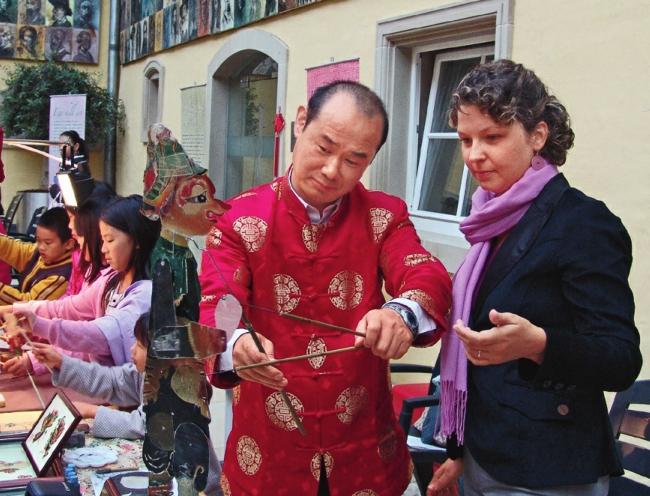Shadow Puppet Theater,the Father of‘Modern Filming’
By staff reporter DENG DI

IN a dimly-lit courtyard, as the overture begins to play, actors sitting behind a white curtain in front of a bright light begin to perform plays using small leather puppets mounted on the end of sticks. Audiences on the other side of the curtain see silhouettes flip around, walk or talk like real human figures. Both children and adults sit riveted to their seats amused by the fascinating legends or moving classic love & hate stories acted out by the shadow puppets. Everyones attention is glued to the curtain, and the small world is immersed in the shadow puppet art.
Two thousand years ago, it was on such a magical curtain that Emperor Wudi (156-87 BC) of the Western Han Dynasty (206 BC-AD 24) enjoyed views of his beloved consort surnamed Li, who had passed away some time earlier. The idea for this art is said to be conjured up by an aide of the emperor named Li Shaofeng. Seeing that the emperor missed Li so much, he tore a leaf from a broad-leaved tree and made a silhouette of the lady with it. Then in the sunlight, the leafs shadow was cast onto the curtain, the sight of which greatly comforted the emperor. This is the earliest legend regarding Chinas shadow puppet art.
Originating during the Western Han Dynasty about 2,000 years ago, the Chinese shadow puppet theater art today is not only a national intangible cultural heritage item of China, but has also been acknowledged by UNESCO as a world cultural treasure. With seemingly simple props, it is actually a comprehensive art that includes modelling, carving, performance, and more.
Beijing Shadow Puppet Theater
Shadow Puppet Theater, or leather-silhouette show, is a drama art unique to China. It combines carving, singing, and storytelling with lighting and shadows. Artisans carve all kinds of figures out of animal (cows, donkey, horse or sheep) hides and then paint them. During the performance, silhouettes of the figurines can be seen clearly performing various moves on a white curtain with a bright light setup in the background. Originating in the capital of the Western Han Dynasty in Shaanxi Province, shadow puppet art is the first art in the world to have voice acting, which thus gave it the name “father of modern filming.”
In China, the shadow puppet theater has many different branches. Beijing Shadow Puppet Theater, with its complete unique carving techniques, figurine modeling, and performing and singing system, stands out from other branches in China.
In the early days, the art of Beijing shadow puppetry was divided into the east school and the west school. Later, the east school gradually became extinct. The existing western school was formed during the Zhengde (1506-1521) reign in the Ming Dynasty. In 1842, Lu Decheng, a man of Manchu ethnicity, inherited the art and established the Beijing Xiangshun Shadow Show Troupe. Since then, the western shadow show has been handed down from generation to generation in the Lu family for more than 100 years till today.
During its long formative period, Beijing shadow puppetry has absorbed the tunes of northern Kunqu Opera, Peking Opera, and other styles of folk music. There are unique artistic skills utilized throughout the performance, such as looking into a mirror, weeping, and dressing up.
Besides, in modelling, it draws a lot from the Peking Opera. The facial makeup or costumes that audiences see in the Peking Opera can also be found on the figurines of Beijing shadow puppets.
Production and Performance
Shadow puppet figurines are made in a severaltiered process that includes material selection, carving, coloring, sewing, and painting. There are two essential tools for the production of Beijing leather silhouettes: a wax plate and a carving knife.
To make a wax plate, the artisan first cooks a mixture of yellow wax, beef tallow, and spices. Then, he pours it into a metal or wooden container to cool. Finally, after pressing it out tightly, a wax plate comes into being. What is good about wax plates is that they can be restored to their original state even after being used for a long time.
Tools used in the making of the figurines include awls and scissors. However, a wax plate and a carving knife are the main tools used to cut puppets out of animal leather. In the past, artisans used wooden knives to do the job, but todays knives are much sharper. In making Beijing shadow puppet figurines, theres a unique cutting style enabled by the use of just one knife. Regardless of how elaborate the leather puppet is, one knife will suffice.
After the figures are carved, the artisan will then paint the transparent leather with a writing brush and watercolor paint. The selection of colors and the paint of complete patterns are a test of the artisans skill.
The last step is to bind different parts of a carved figurine together with thread and mount them on a thin stick.
The production of shadow puppet figurines determines how far a performance will go. In the hands of skilled craftsmen, shadow puppet figurines are lifelike, and even a hair or whisker of beard looks like the real thing. Exquisite figurines are also art products, which could be hung on the wall as a piece of interior decoration.
In addition to this, during the performance, the poles linking the puppets should be held parallel with the ground and at a 90-degree angle with the puppets.
Movable Performances
In the hands of shadow puppet actors, accompanied by high or low pitched singing, small puppets are free to perform various roles from galloping across a battlefield to playing comedy, tragedy or melodrama.
In ancient times, a group of six to seven people equipped with a box of shadow puppets in a rural area would form a shadow puppet troupe. Whether in the market, square or courtyard, a light box and a curtain would be sufficient to start a show. As a result, folk troupes were normally very mobile. A troupe could perform up to 40 plays a day, and when they finished, they packed up all their props and went on to their next destination.
At that time, shadow puppet theater shows were often seen at a traditional fair or a wedding ceremony. Some troupes even stayed up all night to entertain audiences who came from far away to watch them.
To put on a good show, the actors needed to practice a lot. In addition to singing and storytelling, they also needed to be able to manipulate the leather puppets. The agility of the puppets could best reflect an actors skills in the art.
Beijing Shadow Puppet Theater shows add a taste of antiquity to the stage of Beijing. They are welcomed by both the elderly and children. Some exquisite shadow puppets have also been collected by foreign museums.
Passing It on to the Next Generation
Speaking of Beijing Shadow Puppet Theater, Beijing Shadow Show Troupe is an inevitable name. Lu Baogang is the head of the troupe and a national-level inheritor of Beijing shadow puppetry art. Lu is the fifth-generation inheritor of the Beijing Shadow Puppet Theater in the Lu family. He has devoted his life to this traditional art with a deep affection.
In November 2019, Beijing Shadow Show Troupe was added to the list of protected national intangible cultural heritage establishments.
Lu said that there are many schools of shadow puppetry plays in China. At present, more than half of the creative cultural products related to shadow puppetry come from Shaanxi Province, and another 40 percent from Hebei Province. Beijing shadow puppetry lags far behind the others in development. “I am a bit worried. As an inheritor, I have the duty and responsibility to tell young inheritors everything behind Beijing Shadow Puppet Theater to enable them to better carry it forward. Otherwise, this art may become extinct.”
Chen Rui, an apprentice of Lu, joined the troupe in 2013. As a result of her ingenuity and hard work, in October 2018, she was recognized as an inheritor of Beijing Shadow Puppet Theater. Chen said, “As a young woman, I hope to bring vitality into the inheritance team, and contribute my efforts to protect this art.”
Nowadays, the rise of various modern forms of entertainment has greatly marginalized the art of shadow puppetry, an art which once shone brightly in history. At present, there are only around 10 shadow puppet play art groups in China that can manage their own performance and have the ability to recruit apprentices. Pitifully, as older artists retire and pass away, the Beijing Shadow Puppet Theater continues to struggle despite the efforts of Lu and his colleagues. Since 1979, the troupe has not had a fixed performance place and has been in debt.
Lu and his colleagues are seeking opportunities to cooperate with other entertainment forms that the public are interested in to promote the traditional art. “Beijing shadow puppetry is a very traditional art culture. Many young people may not know what it is, so we cooperate with game and movie companies to make it better known in China. The road is still bumpy, but we will figure it out,” said Chen Rui.

